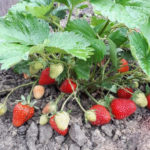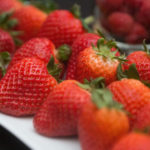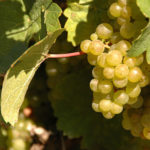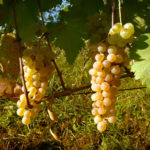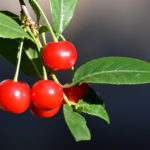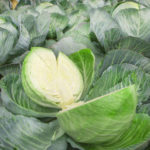Grape variety Italy
Italy is a classic European table grape with more than a century of history, a typical representative of the noble Vitis vinifera species. Bred back in 1911 by the famous Italian breeder Alberto Pirovano. Bikan was chosen as the mother form for crossing, which itself is not very well known, but very well suited for research work due to the functionally feminine type of flower. Pollination was produced by the pollen of the famous Muscat of Hamburg grape, which apparently became the donor of genes for the excellent quality of fruits in the new hybrid.
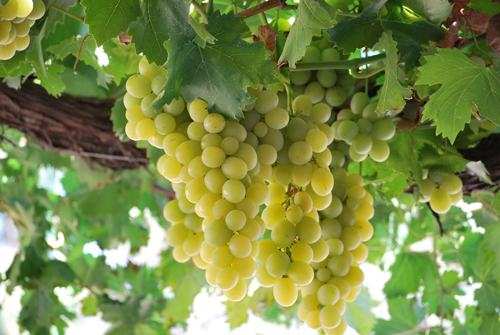
Over the century that has passed since its appearance, the variety has become widespread in its homeland and in many other states of the Old and New World: France, Bulgaria, Chile, the USA, etc. In our country, at one time, it was also quite common in southern viticultural areas, however, subsequently it was in many cases replaced by more modern and not too whimsical varieties. For many years of cultivation in different areas, our heroine has taught many synonymous names: Goldoni, Italian Muscat, Pirovano 65, Muscat Italia.
The main positive qualities of the variety are the high gastronomic and aesthetic properties of its fruits, characteristic of many varieties of European-Asian type cultivated grapes. However, the flip side of these indicators is the extreme delicacy of plants, and their lack of resistance to unfavorable environmental factors, which makes their cultivation rather difficult in comparison with hybrid forms.
Agrobiological characteristics
The bushes are highly vigorous. The crown of a young shoot is painted in a characteristic light color due to the dense tomentose pubescence, through which pink spots appear. Young leaves are distinguished by a golden-green tint. Fully formed leaves are very large, rounded, usually divided into five upward curving lobes with a strong degree of dissection between them. The surface of the leaf blade is dark green, rough, wavy and strongly wrinkled; the back side is covered with pubescence of a bristly-cobweb character. The upper side notches of considerable depth, as a rule, are closed with ovoid gaps; the lower ones are also quite deep, but can be either closed or open. The petiole notch is open, lyre-shaped. The teeth at the edges of the leaf are large in size, triangular with curved edges and a wide base. The flowers of the variety are bisexual, perfectly pollinated in any weather, which practically eliminates such a problem as pea berries. Annual growth ripens well - by 75-80% of its length. Ripe vines are brown with darker areas at the nodes. In autumn, the foliage of the grapes turns yellow.
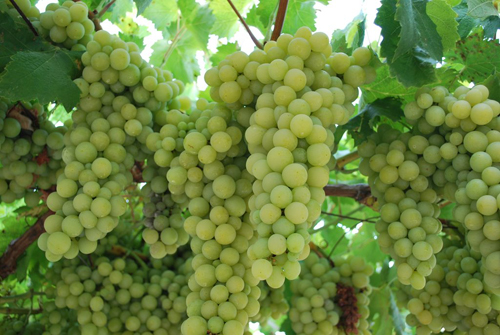
Ripe bunches of Italy reach large sizes - 18-21 cm long, 12-15 cm wide, taking a cylindrical-conical or branched shape, characterized by a not too dense structure. The average brush weight is 550-650 grams. The combs are light green, herbaceous, very fragile, 4-5 cm long. The berries are massive, oval or ovoid, 26-30 mm long and 18-20 mm in diameter, well aligned in size. Due to the relative looseness of the bunch, they are not squeezed or deformed against each other. The mass of one hundred grapes ranges from 550 to 630 grams. The pulp is juicy and fleshy, of excellent harmonious taste with an unusual, but very attractive aroma, which has absorbed the tones of citron and nutmeg. The sugar content of the juice of grape berries differs depending on the climate and the time of harvest, varying in the range of 15-19 g / 100 ml, the titratable acidity is also unstable - 6-10 g / l.The grape skin is thick and firm, its matte surface is yellowish-amber colored and covered with a thick layer of protective pruin. The seeds are large, 2-4 in the berry. In the total mass of the crop, the content of juice is 79-80%, ridges - 3-4%, skins and dense parts of the pulp - 15-16% and seeds 1-2%. Fresh fruit tasting scores reach 9 points.
Basically, the harvested crop is used for direct consumption as food. Italy is one of the great dessert varieties, but, unfortunately, it is not often found on the domestic markets. Farmers prefer to cultivate easier-to-produce varieties, which our heroine loses in profitability due to the need for careful labor-intensive care. Today you can taste real classics only by purchasing imported grapes in large retail chains, or by growing it yourself. In the latter case, surplus abundant harvests are quite suitable for preparing blanks for the winter that are excellent in taste, color and aroma. Juices, compotes, preserves and marinades made from the fruits of the Italian heroine will not leave anyone indifferent. It is impossible not to mention the suitability of these grapes for long-term storage, which is possible due to the dense pulp of the berries, strong skin and good attachment to the crest. For the same reasons, the crop can withstand long-distance travel without any problems and damage.
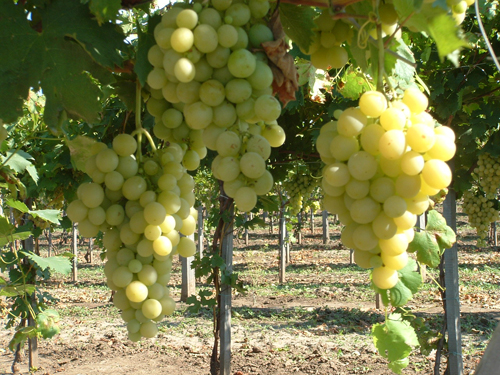
The duration of the growing season, calculated from the time of budding, until the onset of the removable maturity of the bunches, is 150-160 days. The sum of active temperatures required for plants during this time reaches 3200-3300 ° C. According to these parameters, the variety is classified as a late ripening variety that can grow and bear fruit normally only in the south of our country. Moreover, even here harvesting does not begin until the end of September. Outside of the traditional wine-growing regions, the Italian guest is likely to have insufficient vine and crop maturity. Very weak frost resistance does not contribute to its advancement to the north. With a critical indicator of -18 ° C, Italy, everywhere in domestic conditions, requires the shelter of the vine for the winter. Is that in the subtropical climate of the Black Sea coast there is the possibility of its cultivation in non-sheltering culture.
Grape yield indicators are contradictory. On the one hand, she is able to demonstrate excellent productivity in some years, but she cannot boast of constancy in this matter. In production conditions, record yields reached 225 kg / ha, and on personal plots, bushes usually bring about 10-15 kilograms of bunches. Naturally, all this - with good agricultural technology. In conditions of insufficiently qualified care, the variety sharply worsens its already low vines fertility rates, punishing the negligent owner with very modest harvests. The usual percentage of productive shoots is 35-45%, the fruiting rate is 0.3-0.5, and the fertility is 1.1-1.2. The advantage of this is the absence of the need to thin out the inflorescences on the shoots, and the disadvantage is a large amount of work when breaking. Italy is not inclined to overload.
After the onset of technical ripeness, grapes can remain on the vine only in the warmest regions with a fairly long frost-free period. If there is such an opportunity, this can be done without much fear, since the berries are not prone to cracking even in rainy weather, and thanks to the strong skin, they are well protected from wasps attack. Once fully ripe, the grapes accumulate additional sugar and their varietal aroma is enhanced, which, of course, adds points to their tasting score.
Agrotechnical features
A natural condition for good productivity and high quality of fruits of purebred "vinifera" is its exactingness to care, protection from diseases, pests and winter cold. Italy is no exception in this regard, and therefore a winegrower who decides to cultivate this variety must be aware that he will require a lot of attention to himself.
For the placement of the vineyard, the most heat-provided areas are chosen. The best option would be a southern slope, and ideally the upper part. In the conditions of a personal plot, the microclimate of the southern slope can be imitated by planting bushes on the sunny side of a house or other buildings, which will protect the grapes from northern winds and, thereby, raise the sum of active temperatures by several hundred degrees.
The variety is susceptible to root aphids, and therefore its reproduction occurs in most cases by grafted seedlings on phylloxera-resistant rootstocks. Some of the most suitable rootstocks for him are Riparia x Rupestris 101-14 and Berlandieri x Riparia Kober 5BB, with which he shows good affinity. The distance between vigorous plants during planting should be chosen sufficient to exclude their oppression by each other as a result of strong thickening. Therefore, the food area for each of them is allocated at least 4.5-5 square meters.
Shelter of the aboveground part of the vine bushes for the winter is one of the main conditions for maintaining their viability and sufficient productivity. On carelessly insulated plants, there is a significant percentage of frost-damaged eyes, which sharply reduces the yield of the current year. Therefore, a simple and widespread method of covering the vine with soil may not be enough, especially in snowless winters. To surely protect delicate Italy from domestic cold weather, it is recommended, after removing the sleeves and cordons from the trellis, to insulate them with organic materials - straw, wood shavings
Pruning fruit bearing plants and green operations in the vineyard must be subordinated to the goal of obtaining the maximum, in terms of quantity and quality, yields. Given the low fertility of developing shoots, especially from the lower buds, fruit arrows are cut long - by 10-12 eyes, and in general, the bushes are loaded with 45-50 eyes. During the debris, numerous sterile shoots are completely removed, or leave a small part of them with an obvious underload of plants with a crop. Inflorescences on fertile vines should not be thinned out.
Finally, great attention should be paid to protecting plantations from fungal diseases. Italy is moderately affected by mildew and gray rot, but especially strongly by mildew, and therefore requires multiple complex treatments with fungicides according to the schemes worked out for susceptible grape varieties. The number of such sprays over a long growing season can be up to ten.
